Tag archives: nuclear power
Following the ups and downs of nuclear energy
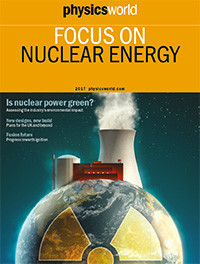 By Margaret Harris
By Margaret Harris
If you’re finding the pace of geopolitical news a bit too rapid at the moment, spare a thought for physicists and engineers working in the nuclear energy sector.
Towards the end of last month, the venerable energy firm Westinghouse Electric issued a press release in which it proudly announced that its AP1000 reactor – a relatively new “passively safe” design in which the reactor core is kept cool without the need for powered pumps or other “active” equipment – had passed a major UK regulatory review. Ordinarily, this would be cause for celebration. The so-called “Generic Design Assessment” process takes years, and completing it helps pave the way for building AP1000s within the UK. An international partnership called NuGen has long hoped to do just that, on a site near Sellafield in north-west England, so in normal times, you might expect it to be celebrating, too.
The most expensive object on Earth, publish or perish, and a physics Magna Carta
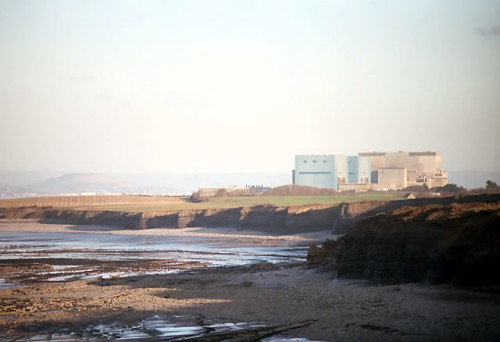
Gold coast: the Hinkley Point C power station will be built next to existing reactors in Somerset. (CC BY-SA 2.0 Richard Baker)
By Hamish Johnston
What will soon be the most expensive object on Earth? The answer, according to Greenpeace, is the Hinkley Point C nuclear power station that is slated for construction in south-west England. According to the BBC, the environmental group reckons the station will cost £24bn ($35bn) whereas EDF – the company that will build it – puts the construction cost at £18bn. In contrast, the Large Hadron Collider at CERN cost a mere £4bn. While the price tag on Hinkley Point C – which should produce 3.2 GW of electricity by 2024 – is eye watering, building a reactor on the cheap is not really an option.
Still, Hinkley Point C will not be the most expensive object ever built by humans. That honour goes to the International Space Station, which the BBC says cost nearly £78bn. There’s something comforting in knowing that the single highest expenditure ever has been on science – maybe civilization isn’t doomed after all.
Physics World 2016 Focus on Nuclear Energy is out now
By Michael Banks
Proponents of nuclear power in the UK have endured an agonizing wait for Hinckley Point C – a European pressurized water reactor (EPR) to be built in south-west England that would fulfil 3.5% of the UK’s electricity needs. Earlier this year, it looked as if the French utility giant EDF would finally give the project the thumbs up and start construction. However, following months of political wrangling – and resignations by senior EDF executives – a final decision by the EDF board is yet to see the light of day.
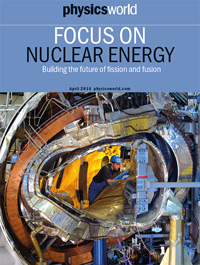
Hinckley Point C is not the only EPR under construction that has been beset with delays and cost hikes: two in China, one in France and one in Finland have also had issues. In this first-ever Physics World Focus on Nuclear Energy, we delve into the EPR design and Hinckley Point C, as well as look ahead to other, more ambitious reactor designs in the pipeline – known as generation-IV designs – that could vastly reduce the amount of nuclear waste produced. Although work on such designs has slowed following the 2011 Fukushima nuclear accident in Japan, supporters argue that generation IV will still play a vital role in the long term.
The focus issue is not only devoted to fission, but fusion too. For decades physicists have dreamed of using fusion to generate electricity and, with construction well under way on the ITER fusion tokamak in Cadarache, France, that vision is now getting closer to a reality. But is ITER the only way forward? We explore how several private firms are developing small-scale fusion technologies, while in Germany a novel “stellarator” device has just started up that promises to deliver a “steady state” plasma.
View all posts by this author | View this author's profile
Lilting to the LIGO tune, Fukushima five years on and more
By Tushna Commissariat
Looks as if LIGO’s gravitational-wave discovery is still rocking all over the world, as you can now groove to the dulcet tones of singer and physicist Tim Blais, who runs the acapellascience channel on YouTube. With some help from the Perimeter Institute in Canada, the singer has created his latest “nerd-pop” parody, titled “LIGO Feel That Space” (sung to the tune of The Weeknd’s “Can’t Feel My Face”). After you listen to the catchy tune above, take a look at this interview with Blais on the Perimeter website to find out just how he creates his songs and how he went from physicist to a viral YouTuber.
Lament for ‘the reactor that can do everything’
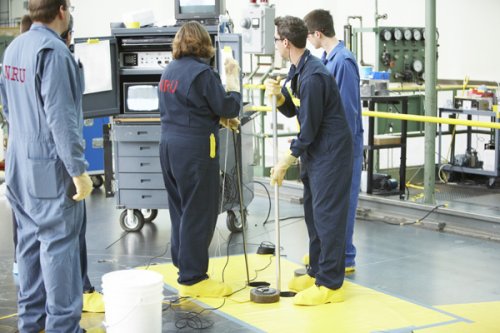
Inside the NRU. (Courtesy: Atomic Energy of Canada)
By Hamish Johnston at the CAP Congress in Edmonton
In 1957 Atomic Energy of Canada built “a reactor that can do everything” at Chalk River, Ontario. Dubbed the National Reactor Universal – or NRU – that facility will shut down for good in 2018 and Canada’s neutron-science community is now pondering its future.
In the short term, physicists will have to travel abroad to use neutron sources, such as those at Oak Ridge in the US and Grenoble in France. The challenge during this 10–15 year period will be to keep the research community together and make sure that vital skills and expertise built up over decades at the NRU will be retained. In the longer term, there are calls for Canada to build a new neutron facility, but it is by no means clear whether that will happen.
Hawking on 1D, Chernobyl fires, psychedelic science and more
By Tushna Commissariat
It’s not often that physics, or indeed a physicist, has much in common with pop music or exceedingly popular boy bands. But earlier this week, at an event at the Sydney Opera House titled “An Evening with Stephen Hawking, with Lucy Hawking and Paul Davies”, an audience member asked Hawking (who appeared in holographic form) “What do you think is the cosmological effect of Zayn Malik leaving One Direction?” Watch the video above to see what Hawking said to comfort the distraught fan and how theoretical physics truly may have all the answers.
Radiation levels near Fukushima, trust in science and fun with correlations
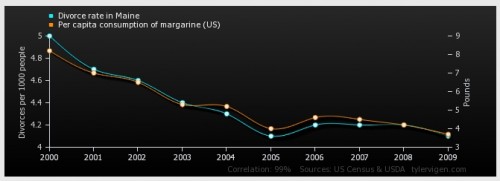
Do divorcees eat more margarine? Or does the butter substitute break up marriages? (Courtesy: Tyler Vigen)
By Hamish Johnston
This week’s Red Folder begins in Japan, where the 2011 disaster at the Fukushima nuclear power plant continues to cause misery for the 100,000 or so local people who still cannot return to their homes. But who is to blame? Writing in World Nuclear News, Malcolm Grimston of Imperial College London argues that radiation levels in much of the current exclusion zone are no higher than natural levels in other parts of Japan – and much lower than natural levels in some other populated regions worldwide. Grimston concludes that “an overzealous infatuation with reducing radiation dose, far from minimizing human harm, is at the heart of the whole problem”. His article is called “What was deadly at Fukushima?”.
Lateral Thoughts: Voices from history
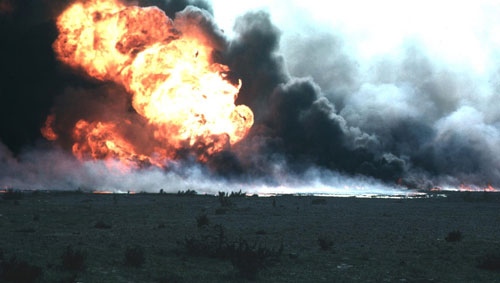
A burning oilfield in Kuwait after the Gulf War. (Courtesy: US Army)
By Margaret Harris
This is the third in a series of blog posts about “Lateral Thoughts”, Physics World’s long-running humour column. Click to read the first and second posts.
As part of Physics World’s 25th anniversary celebrations, I’ve been reading through the archive of “Lateral Thoughts”, the magazine’s column of humorous or otherwise off-beat essays about physics. My goal is to get a better feel for the topics that have amused and preoccupied Physics World readers over the past quarter-century, and to understand how the community has changed.
While most Lateral Thoughts have focused on the world of physics, the archive shows that every now and then, the wider world intrudes. The results can be fascinating, sobering and sometimes even disturbing. Consider the essay “Soft zlotys for western hardware”, in which the metallurgist Jack Harris describes taking a research trip behind the Iron Curtain to Poland. “In science, as in other areas, I was struck by how little real contact there was with Russia,” Harris wrote. His Lateral Thought was published in July 1989. Two months later, Poland defied its puppet-masters in Moscow by electing its first non-communist government since the Second World War.
View all posts by this author | View this author's profile
Spacecraft duets, suprise supernovae, the dark side of physics and more
By Tushna Commissariat
While you would not actually be able to hear the uplifting notes of the music in the vast emptiness of space, a newly composed string and piano orchestral piece has unexpected ties to the cosmos. That’s because it is based on 36 years’ worth of data from NASA’s Voyager 1 and 2 spacecraft. Domenico Vicinanza, a trained musician with a PhD in physics who works at GÉANT, a European data-network company, says that he “wanted to compose a musical piece celebrating Voyager 1 and 2 together, so I used the same measurements (proton counts from the cosmic-ray detector over the last 37 years) from both spacecrafts, at the exactly same point in time, but at several billions of kilometres of distance [of] one from the other”. The result of this “data sonification” is a rather beautiful piece of music – one of the best examples of physics and the arts coming together that we have heard. Of course, the story garnered considerable interest…you can read more about on the Wired and Guardian websites.
View all posts by this author | View this author's profile
Nuclear-explosion survival tips, gravity-defying beads, big questions and more
By Tushna Comissariat
Would you know exactly where to run and shelter in the event of nuclear fallout in your city? Would it be best to stay where you are or move, and for how long should you stay inside before venturing out into your post-apocalyptic world? If these questions have plagued your mind, you can now turn to a new model developed by Michael Dillon, an atmospheric scientist at the Lawrence Livermore National Laboratory in California, US. Dillon’s practical model outlines simple ideas and suggestions that the average person – without advanced equipment and know-how – could apply in the event of a low-level nuclear attack, which is the most plausible type likely to take place in today’s political climate. You can read all about about the model on both the io9 website and in Science magazine, and then map out your perfect route.